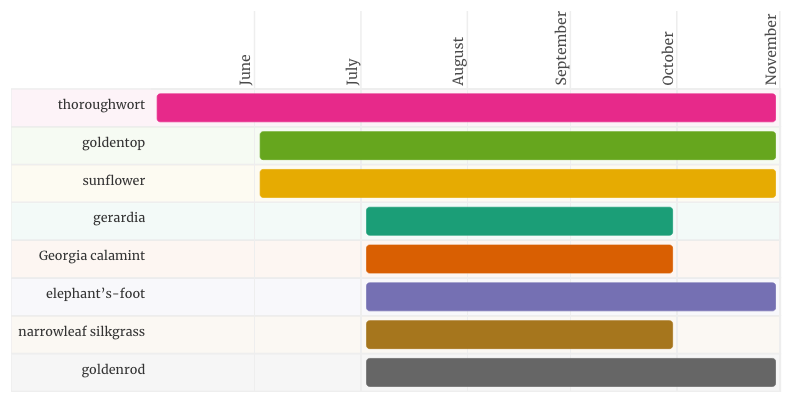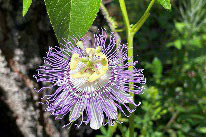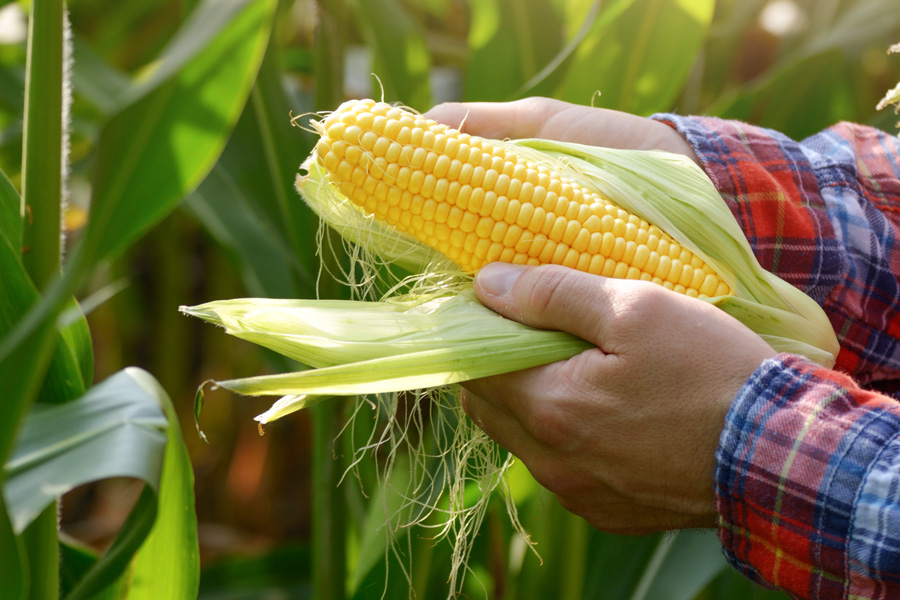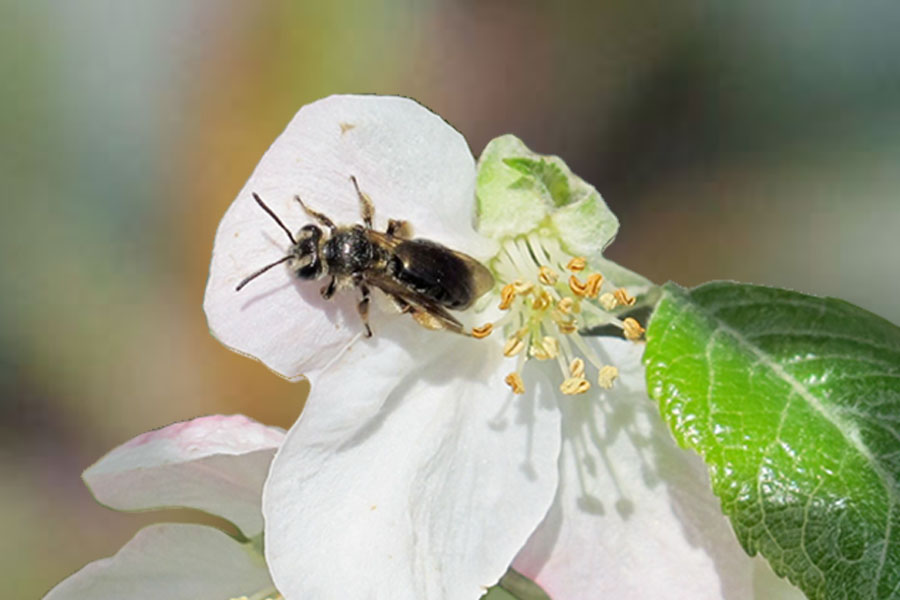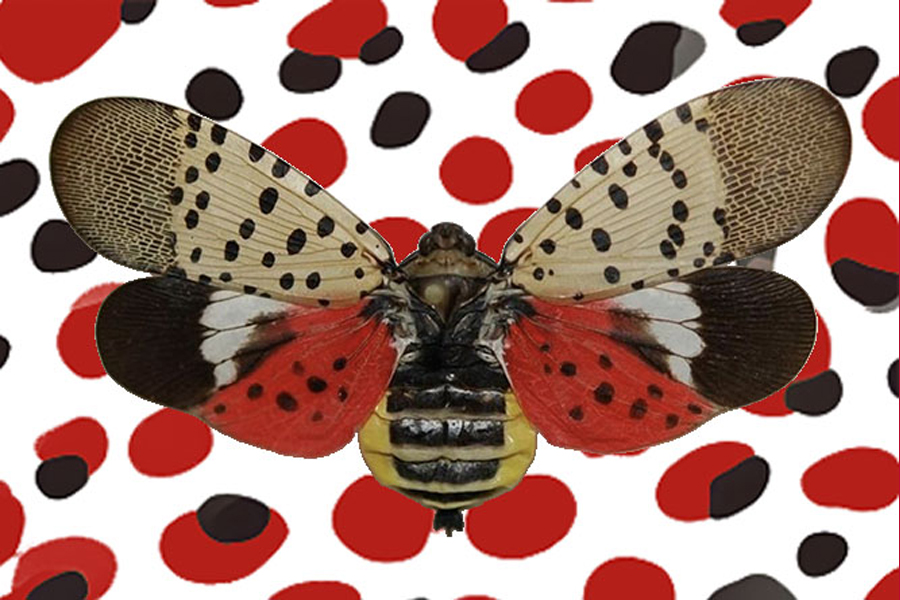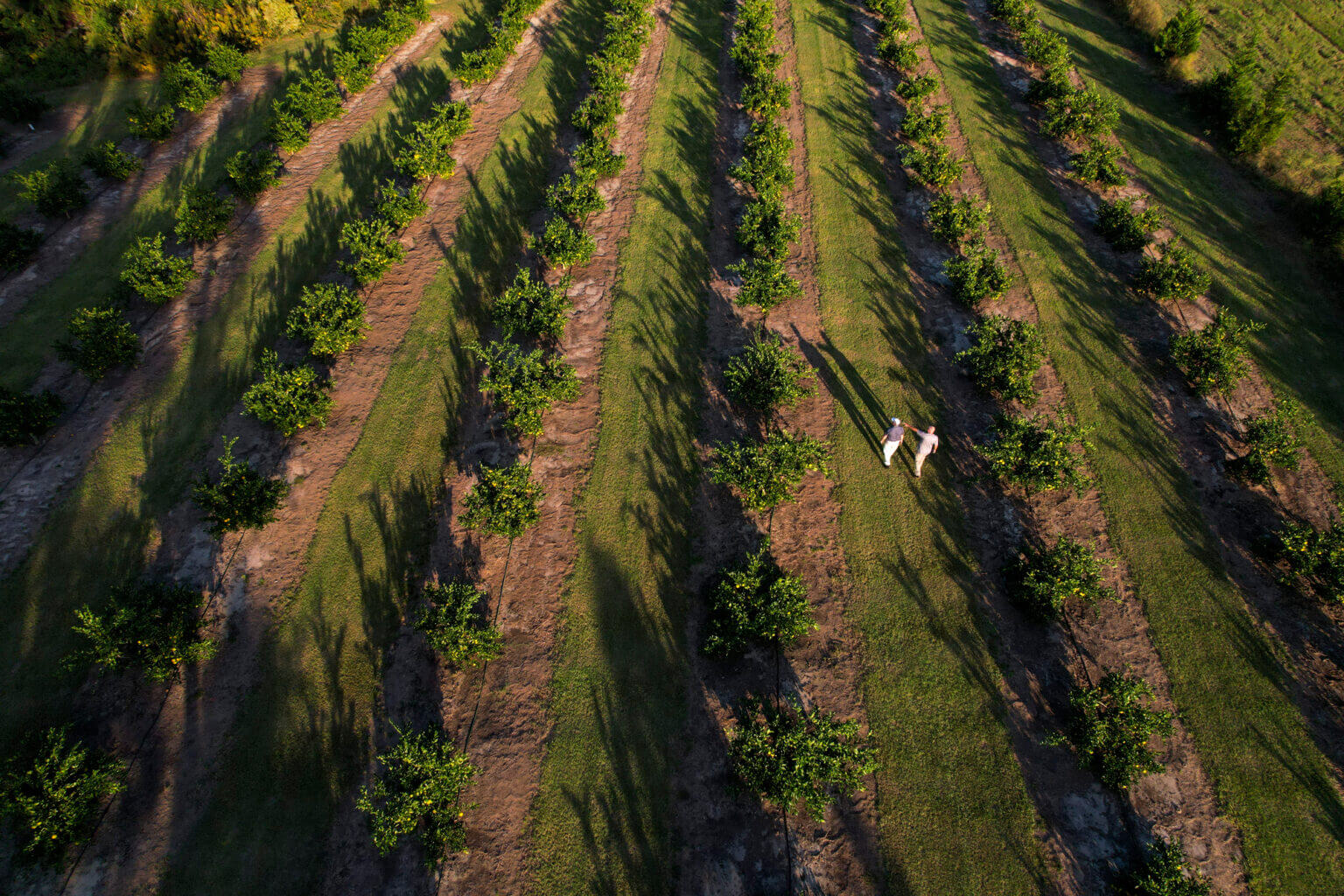Wildflowers not only beautify the landscape but also provide food and shelter for myriad insects, birds, and mammals. Georgia is rich in endemic (belonging in a particular area or environment) species which grow in a wide variety of habitats, from coastal dunes and pine sandhills to savannas, meadows, and forests. Although many species are primarily seen in undisturbed natural habitats, others have adapted to human- created landscapes, such as roadsides and farms, and are frequently seen on road banks and edge habitats.
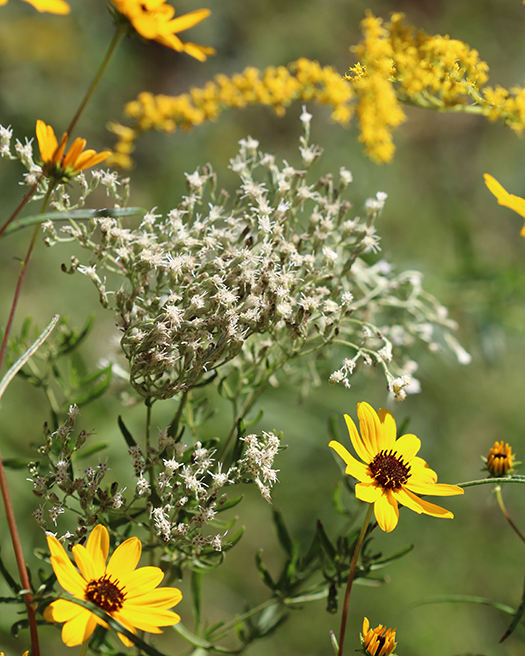
This publication is intended as a visual guide to common herbaceous plants encountered mainly in sunny areas in South Georgia. Although by no means inclusive or extensive, the list contains plants that are easy to recognize and valuable for wildlife. Care should be taken to preserve such species and not remove them from the wild. It is our hope that citizens will learn to recognize these beautiful plants and purchase them from local nurseries to plant in their gardens.
The species listed are known to attract a wide variety of bees, wasps, beetles, flies, and other beneficial insects, and are recommended for pollinator habitats on farmland. They bloom across the seasons, between early spring and fall. At least three species from each season should be included in a planting to ensure abundant and diverse insect presence.

Illustrations refer to terms used to describe plant parts throughout this publication.
Leaf Shapes
Ovate

Lanceolate

Cordate

Obovate

Elliptical

Linear

Leaf Arrangements
Alternate

Opposite

Whorled

Basal Rosette

Palmately Compound
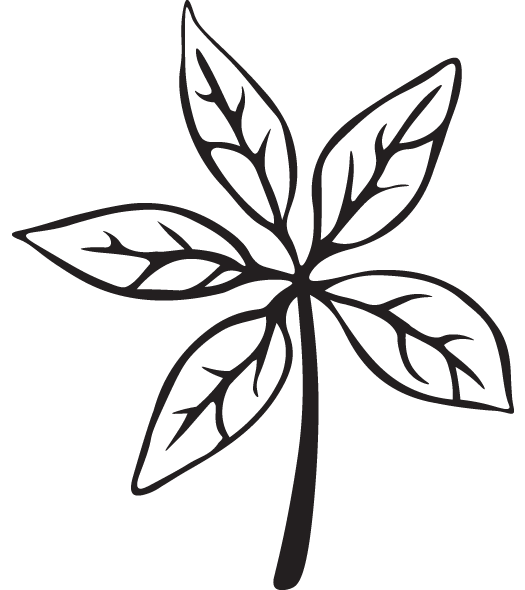
Trifoliate Leaf
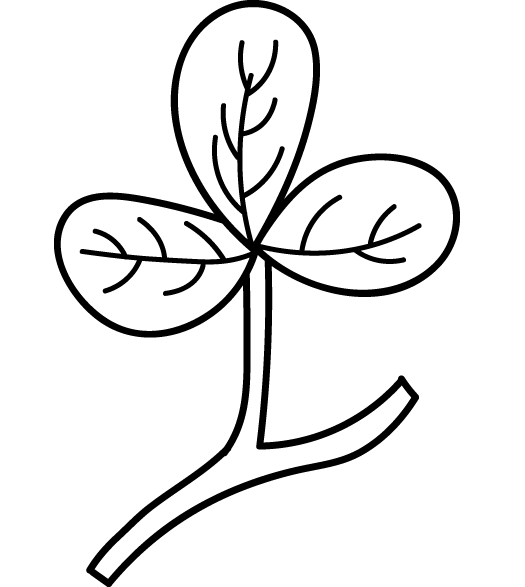
Pinnately Compound
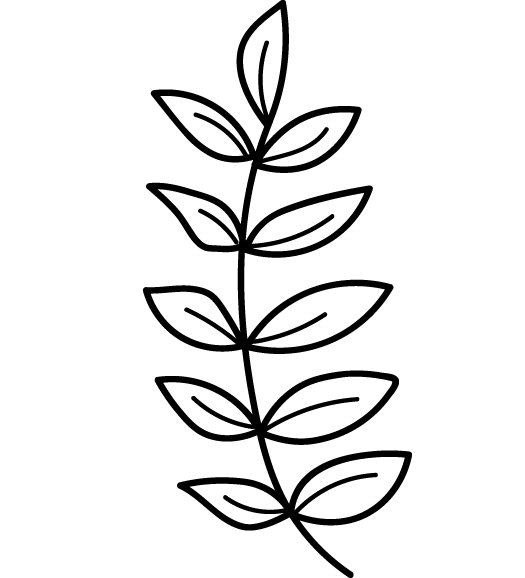
Bipinnately Compound

Types of Inflorescences
Panicle
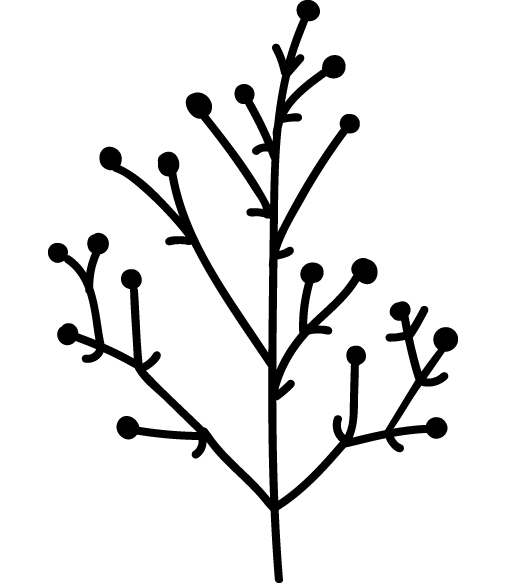
Raceme
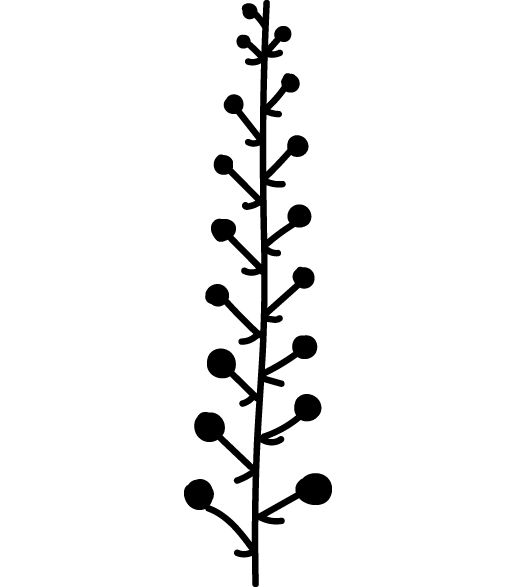
Spike
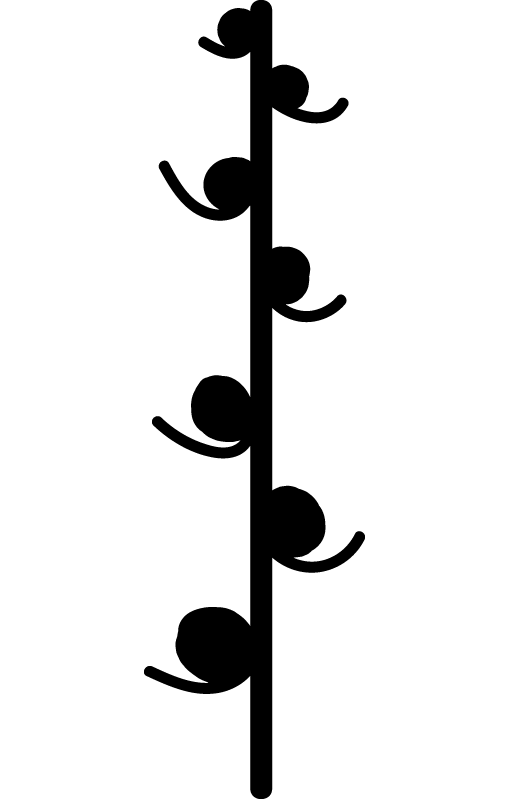
Cyme
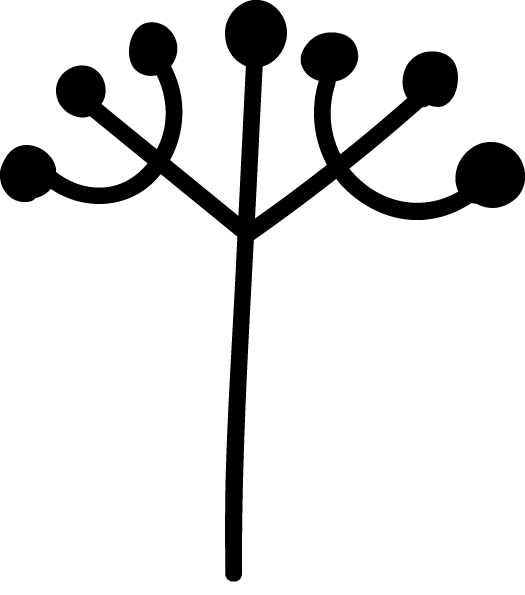
Umbel

Head

Corymb

Species That Bloom in Spring
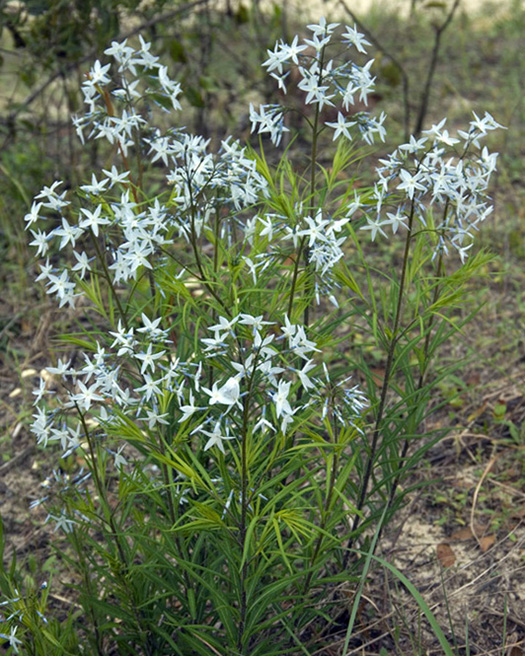
sandhills bluestar
Amsonia ciliata (P)
1–2 ft; clump-forming, erect to ascending, narrow to 3 in. needle-like leaves; 0.5 in. wide pale blue flowers in a loose cluster at top of stem shaped as a five–lobed “star”
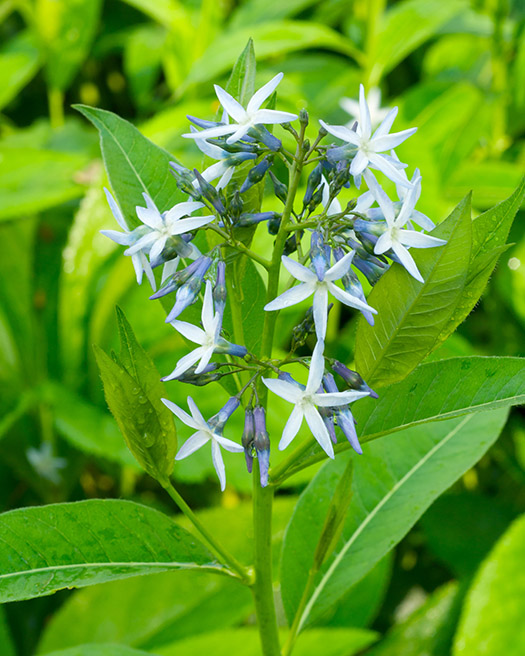
eastern bluestar
Amsonia tabernaemontana (P)
1–3 ft; slender, erect, narrowly oval to lance-shaped leaves; powder blue flowers in a 0.75 in. wide pyramidal terminal panicle shaped as a five-lobed “star”
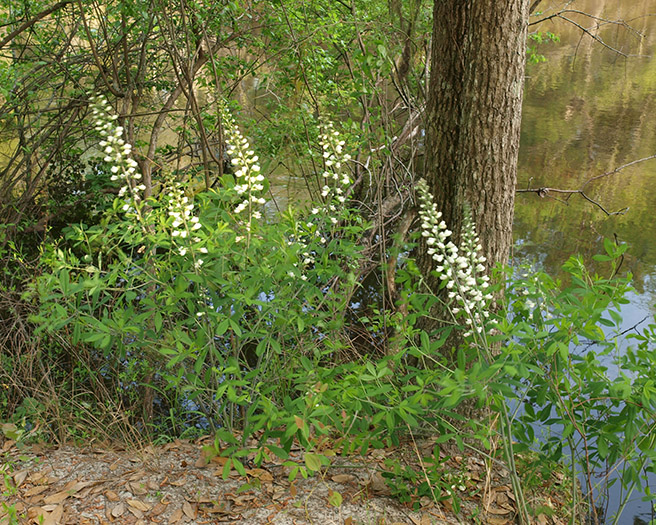
thick pod white wild indigo
Baptisia alba (P)
2–3 ft; bushy, upright, clover-like, trifoliate, bluish-green leaves, leaflets up to 2 in. long covered in small hairs; white, pea-like flowers up to 0.5 in. long borne on terminal clusters (racemes) above the foliage
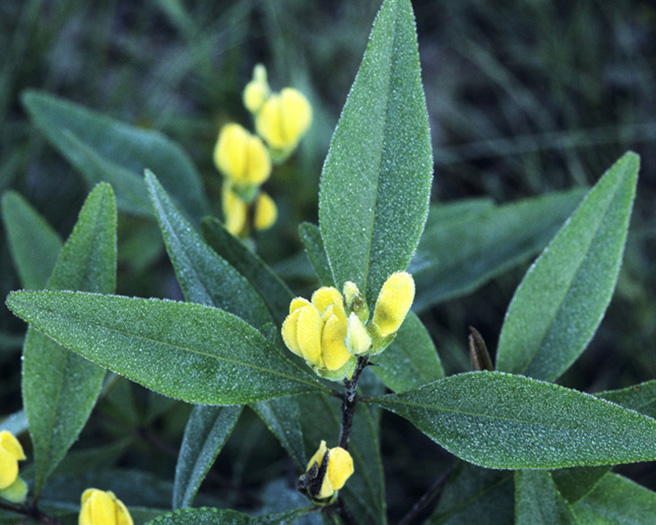
gopherweed
Baptisia lanceolata (P)
2–3 ft; bushy, trifoliate, elliptical leaves with 1–4 in. long leaflets with smooth margins; yellow, typical pea-like flowers in leaf axils in short, loosely clustered racemes
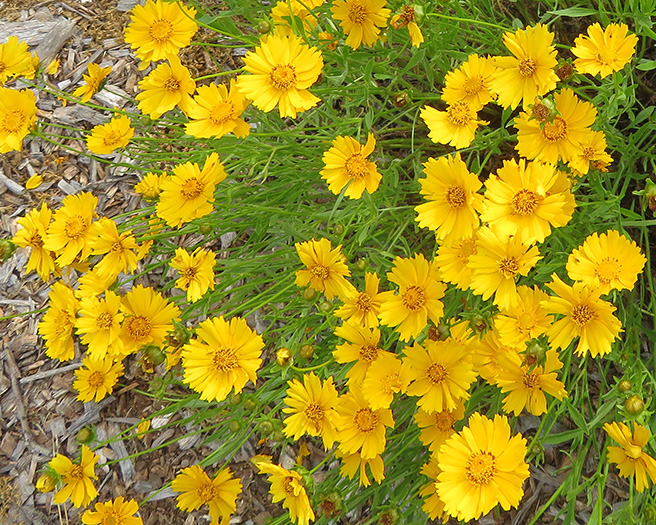
tickseed
Coreopsis lanceolata, C. delphinium, C. gladiata, C. linifolia, C. nudata (P)
1–2 ft; erect to ascending in clumps, one to five elliptical to oblong lance- shaped leaf nodes below the inflorescence, 1–2 in. solitary flower heads with eight yellow ray florets
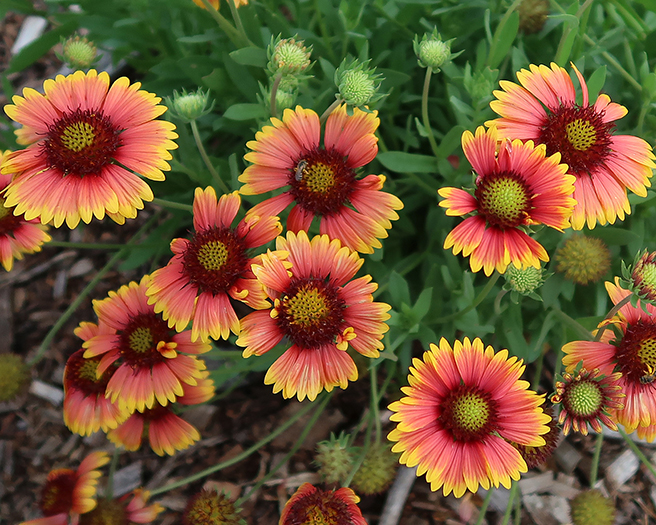
blanket flower
Gaillardia pulchella (A)
1–2 ft; bushy annual, 3 in. long toothed or lobed linear to spoon-shaped leaves, 2.5 in. wide daisy-like flowerheads, eight to 14 three-toothed ray florets
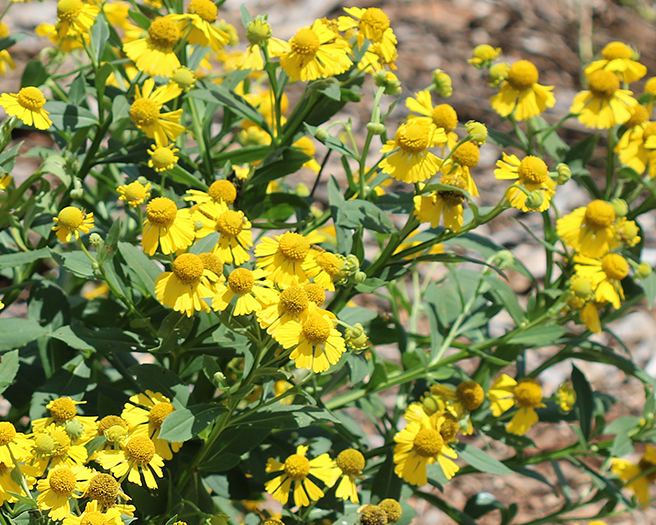
southern sneezeweed
Helenium autumnale, H. flexuosum, H. pinnatifidum, H. vernale (P)
1–3 ft; 6 in. narrowly lance-shaped to oval leaves, 1.5–2 in. wide flower heads, eight to 15 yellow drooping narrow wedge-shaped and three-toothed ray floret disks with brown ball-shaped central disk
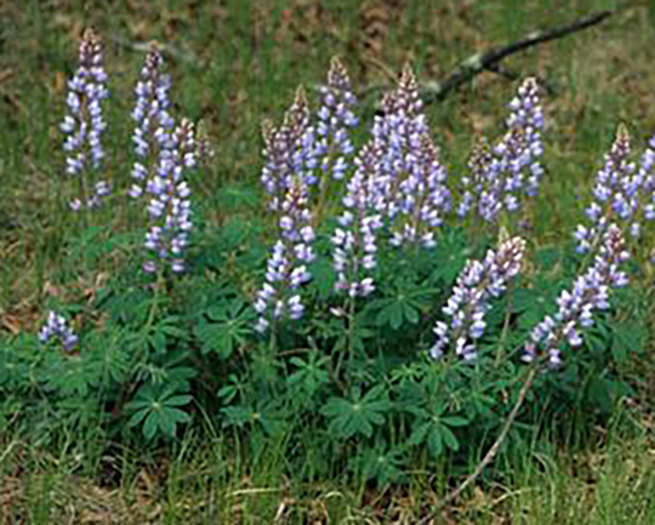
sundial lupine
Lupinus perennis (P)
8–30 in.; erect clumped; leaves with long petioles, five to 11 oblong 0.75–2 in. leaflets, erect terminal 4–10 in. blue typical pea-shaped flowers
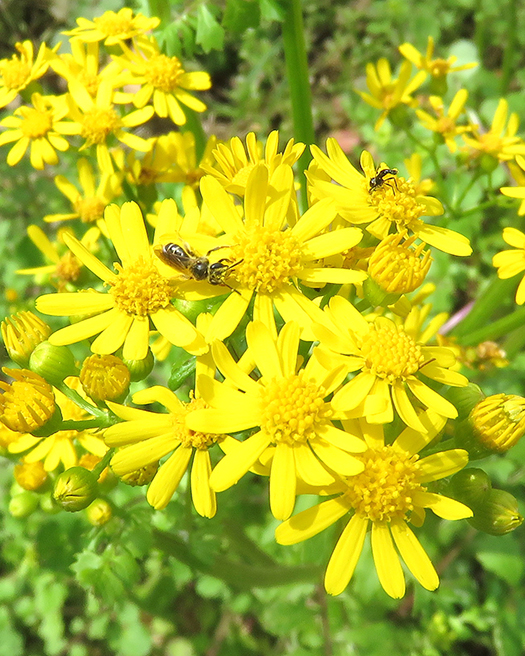
butterweed
Packera glabella, P. tomentosa (A)
1–3 ft; light green to reddish green stems, elliptical to oblong 2–8 in. long leaves, deeply lobed, irregularly shaped, toothed 0.5 in. wide flower heads in terminal clusters, five to 15 yellow ray florets around a center disk of tiny florets
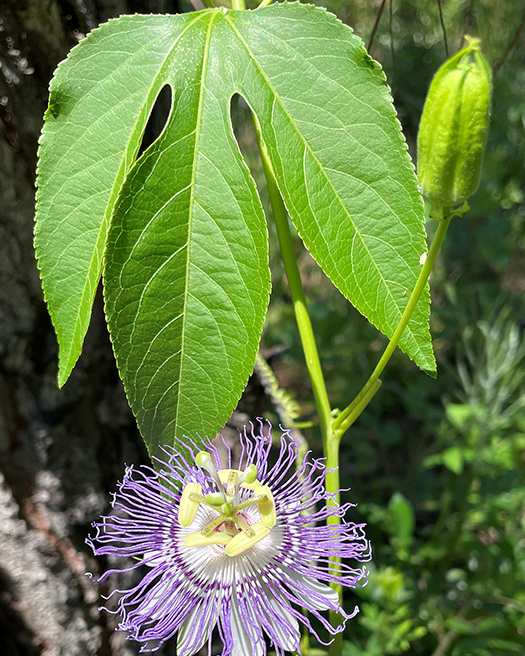
purple passionflower
Passiflora incarnata (P)
Up to 12 ft vine; erect, trailing, or climbing by coiled tendrils; palmately lobed 2.5–8 in. long petiolate leaves, toothed, leathery, smooth, or with short, soft hairs beneath; 2.5 in. wide solitary flowers on short axillary stalks, showy complex: five oblong sepals with hornlike extensions, green outside, white inside, five sepal-like petals; a “crown” of purple and white thread- like segments
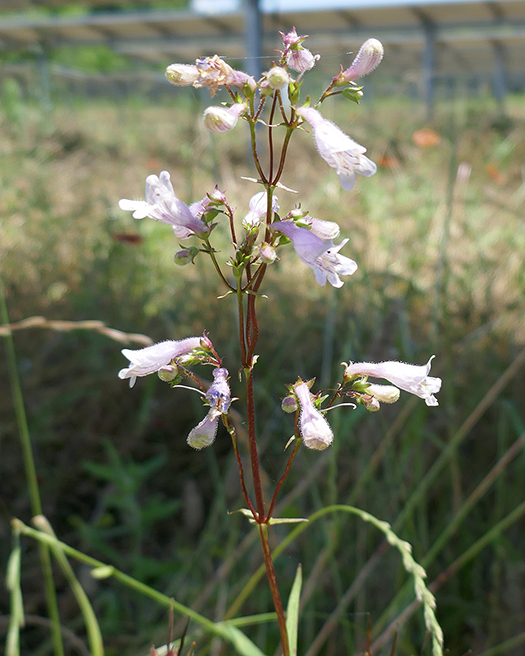
southern beardtongue
Penstemon australis, P. laevigatus (P)
8–28 in.; one to several stems, 4 in. long lance-shaped sessile leaves often tinged reddish-purple, coarsely toothed white and pink to purple flowers up to 1 in. long in a tubular terminal panicle
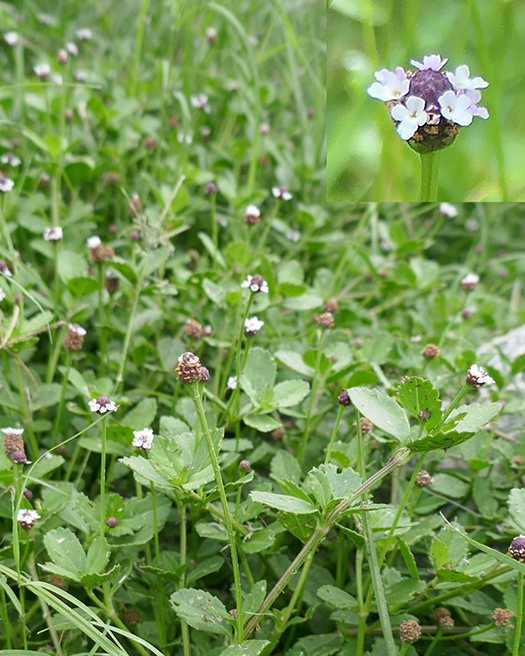
turkey tangle, fog fruit
Phyla nodiflora (P)
1–2 ft; clump-forming, erect to ascending, narrow to 3 in. needle-like leaves; 0.5 in. wide pale blue flowers in a loose cluster at top of stem shaped as a five–lobed “star”
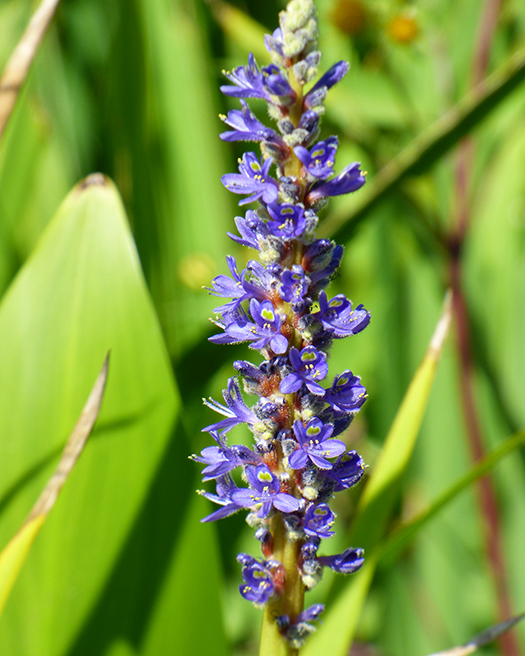
pickerelweed
Pontederia cordata (P)
1–4 ft; unbranched stems, basal, erect, long-petioled, narrowly oval to arrow-shaped leaves, 8 in. long, fine parallel veins, 0.5 in. wide blue-violet flowers in 5 in. dense terminal spike, six spreading unequal lobes

meadow-beauty
Rhexia mariana, R. alifanus, R. lutea, R. nashi, R. virginica (P)
32 in.; 4–angled stems, 0.75–2.5 in. long 3–veined elliptical to lance- shaped leaves, pale rose to white flowers in 2 in. wide branching terminal clusters
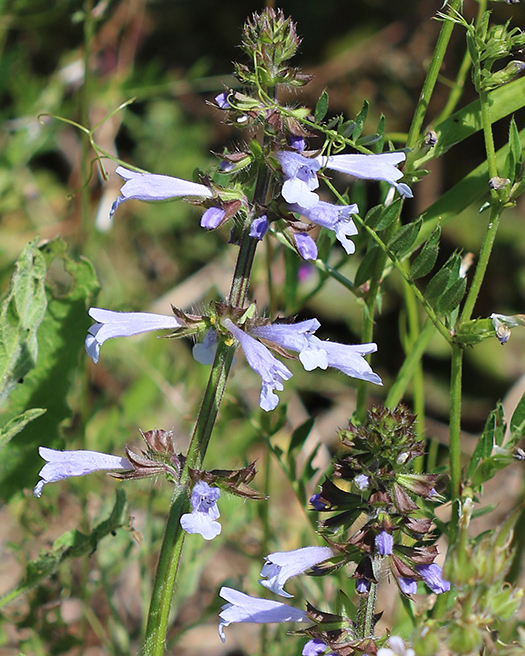
lyreleaf sage
Salvia lyrata (P)
1–2 ft; 4-angled erect stems, dark reddish-purple oblong-oval shaped leaves, 0.5–1.25 in. long blue to lavender flowers in widely spaced whorls in a loose terminal spike
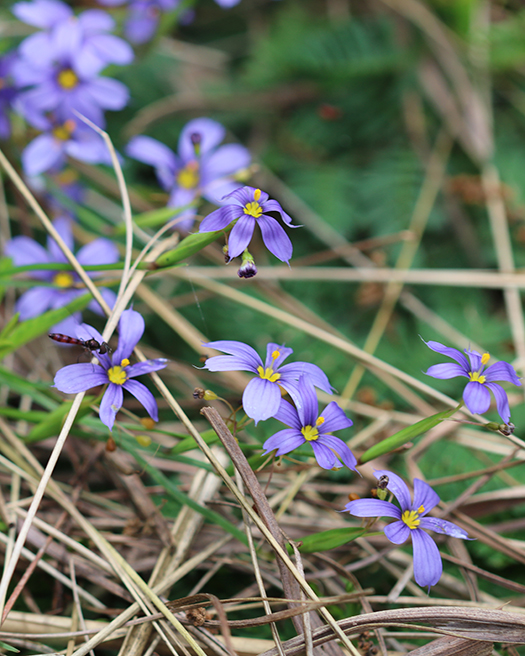
blue-eyed grass
Sisyrinchium spp. (P)
28–18 in.; flattened and narrowly winged stem branching and sometimes bending at one to two nodes, linear and grasslike 14 in. long pale bluish green leaves, blue-violet flowers in small 0.5–0.75 in. wide cluster
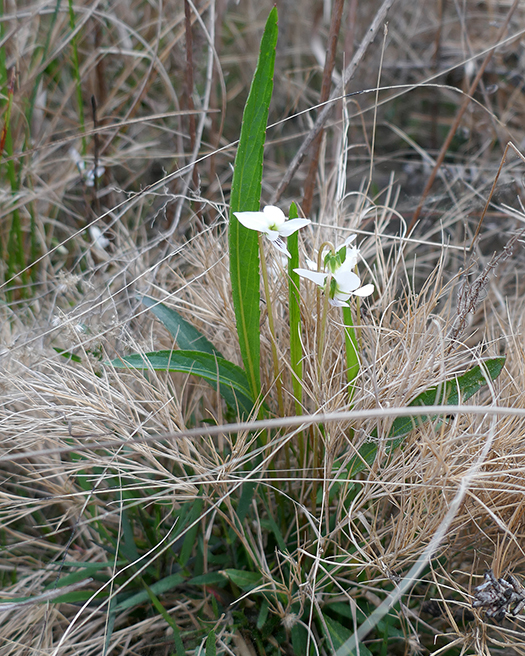
violet
Viola lanceolata, V. palmata, V. primulifolia, V. septemloba, V. villosa, V. walteri (P)
2–10 in.; stemless, leaves in basal cluster, reddish petioles, 1–6 in. long, white flowers (V. lanceolata) with five petals.
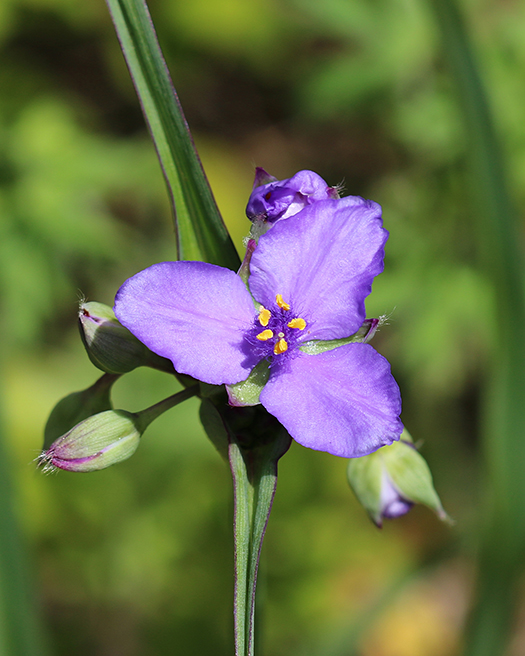
spiderwort
Tradescantia ohiensis (P)
1–4 ft; erect to ascending, clump forming, sessile linear or lance-shaped 18 in. long bluish green leaves, blue, purple, or rose flowers in terminal cluster, two leaflike, 3 in. long sharp pointed bracts.
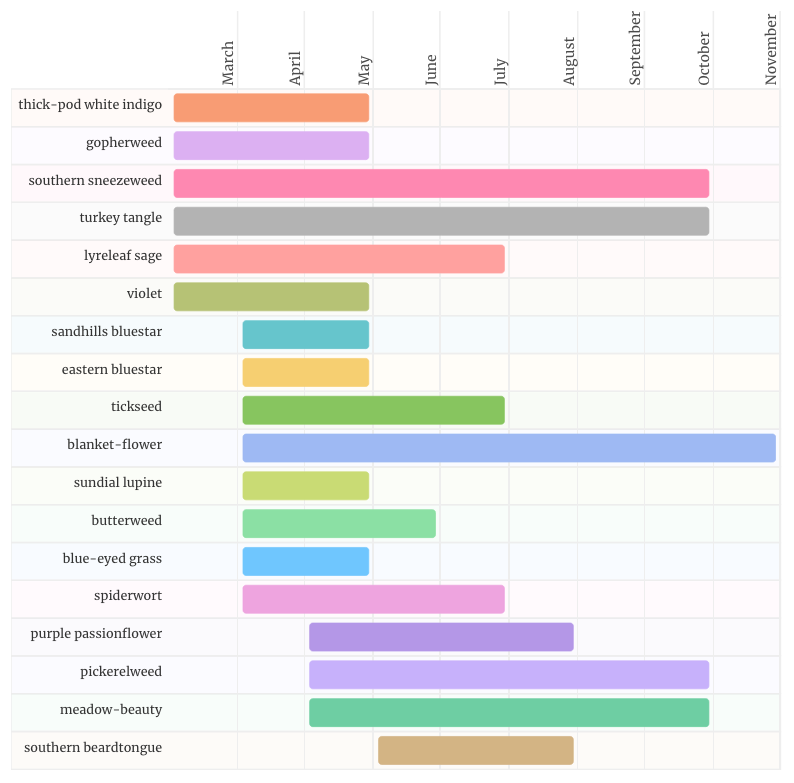
Species That Bloom in Summer
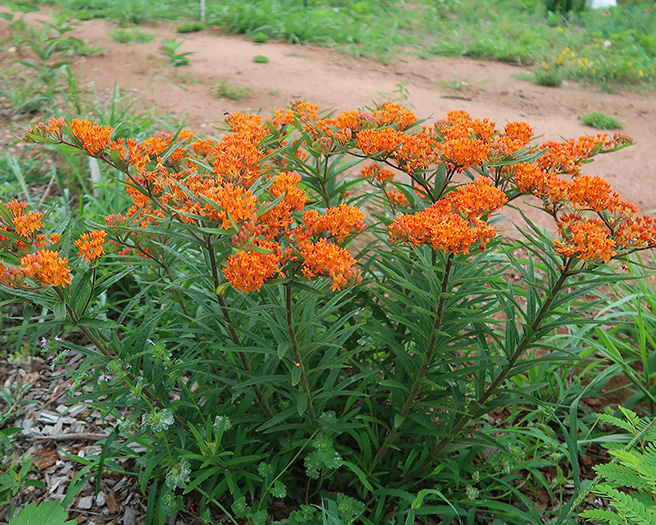
butterfly milkweed
Asclepias tuberosa (P)
1–3 ft; erect to ascending, mostly unbranched, reddish-purple narrow oblong to lance-shaped 4 in. leaves with short petioles, orange to reddish 0.5 in. flowers in terminal and upper axillary compound umbels, five strongly reflexed corolla lobes
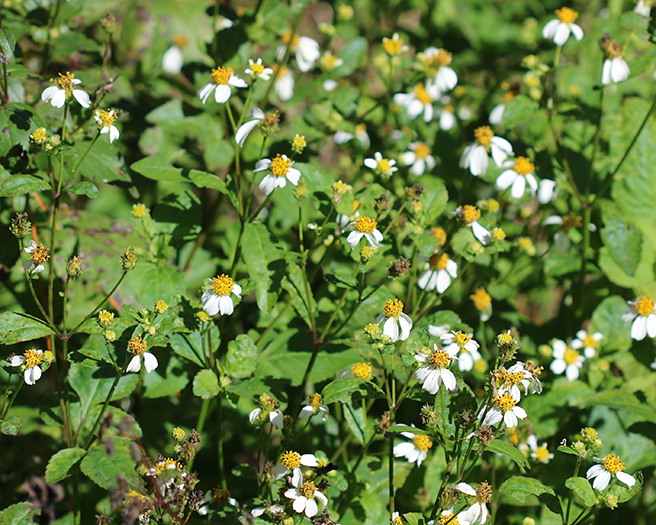
beggarticks
Bidens alba, B. frondosa (A)
1–4 ft; stems branched in upper half, often purplish 0.5–4.5 in. long petioled leaves pinnately divided into three to five lance-shaped flower heads, usually solitary or in two- to three-stalked clusters, orange-yellow heads, five–lobed tubular disk florets, nonnative, widelly naturalized species

spurred pea
Centrosema virginiana (P)
5 ft; twining or climbing vine, leaves on petioles with tiny lance- shaped stipules, divided into three oval elliptical 2.75 in. leaflets, 1–4 pink or lavender pea-shaped flowers on slender stalks
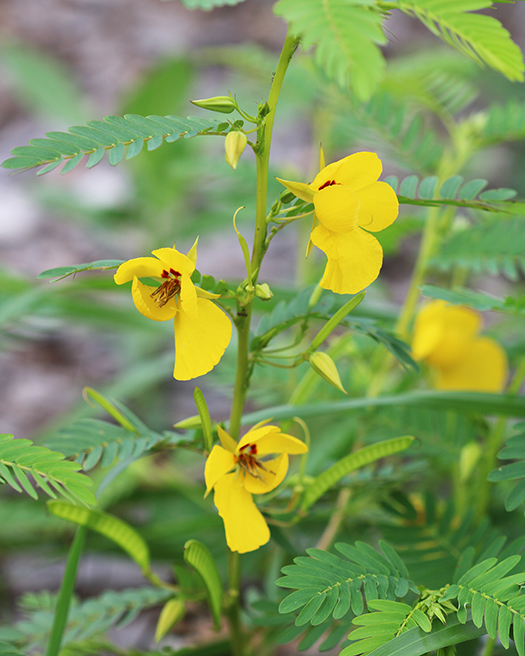
partridge pea
Chamaecrista fasciculata, C. nictitans (A)
6–22 in.; erect to sprawling annual with leaves sensitive to touch, branched light green to reddish brown stems, petiolate leaves pinnately divided into six to 14 pairs of leaflets, bright yellow flowers on 0.5 in. long stalks in small clusters
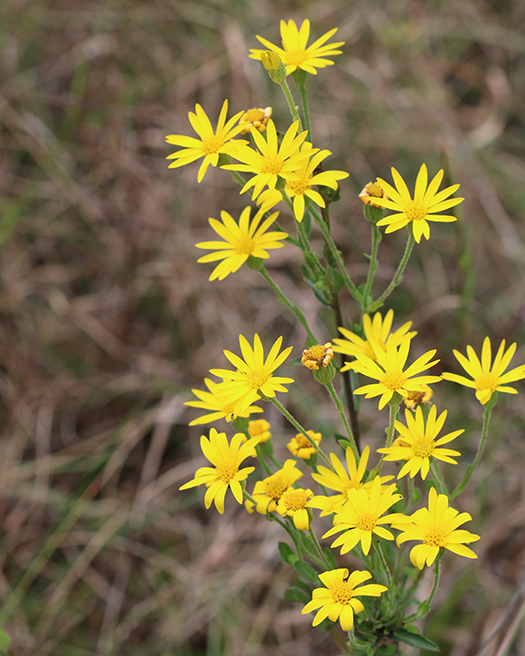
goldenaster
Chrysopsis mariana (P)
1–2 ft; erect to ascending, basal and alternate oblong lance-shaped 0.75–4.5 in. long leaves (stem leaves shorter), 0.75–1.5 in. flower heads in a terminal cluster, 12–25 yellow florets with darker yellow center disk
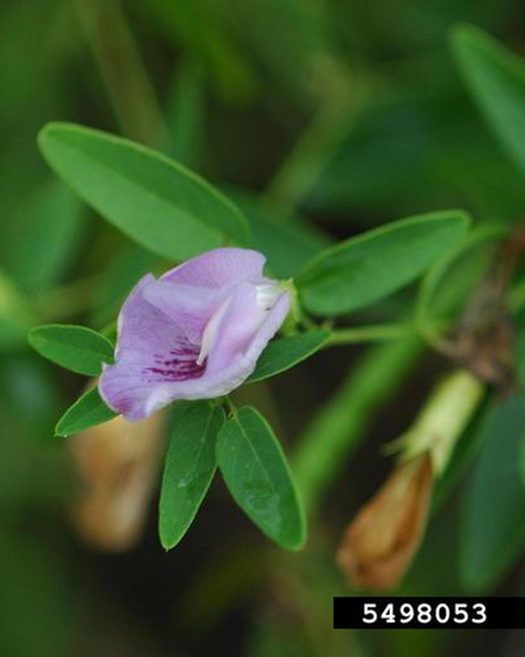
Atlantic pigeonwings
Clitoria mariana (P)
2 ft long vine; smooth and loosely ascending stems, leaves on petioles with pair of stipules at the base divided into three oval elliptical leaflets, pale blue to pink-lavender pea-shaped flowers in one to three clusters

bluemist
Conoclinum coelistinum (P)
1–3 ft; sometimes red-tinged very hairy branched stems, oval to triangular 4 in. long petiolate leaves with three main thin, blunt-toothed, hairy, and smooth veins from the base, flower heads at the end of short branches in 4 in. wide flat terminal clusters
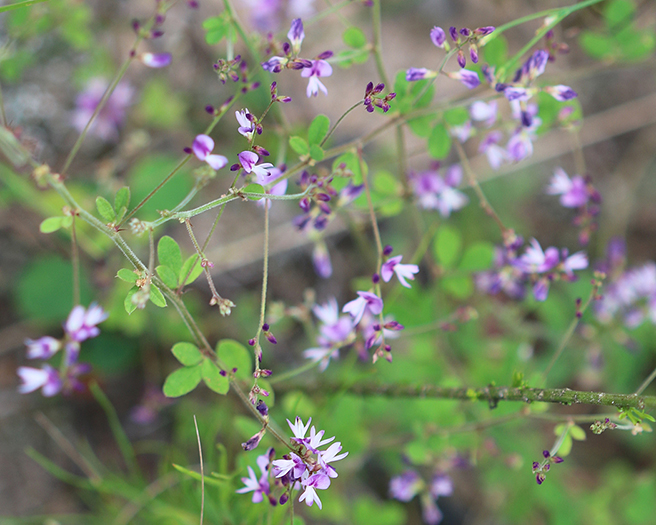
trick-trefoil
Desmodium spp. (P)
1–5 ft; one to several stems from a crown, leaves on petioles with short, narrow stipules, divided into three densely furry, oval to elliptical 1.25 in. long leaflets, long stalked pink to purple typical pea-shaped flowers
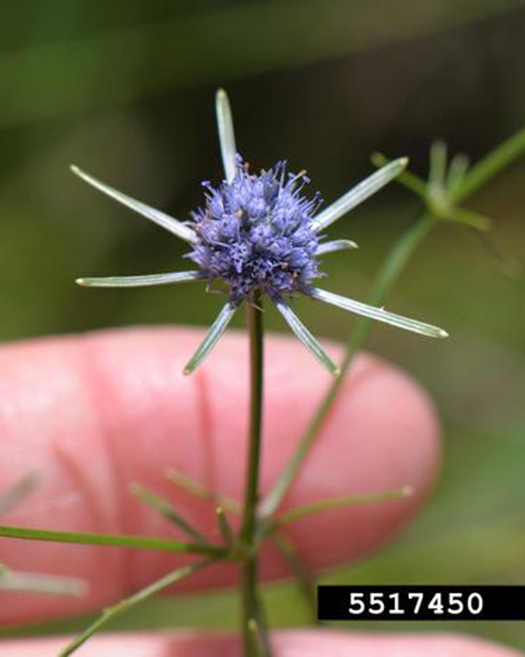
savanna eringo
Eryngium integrifolium (P)
1–2 ft; stems branched above smooth subsessile, oval to lance-shaped 1–2.75 in. long coarsely toothed leaves, smaller upper leaves, greenish blue to blue flowers in compact, thimble-shaped heads less than 0.5 in. wide
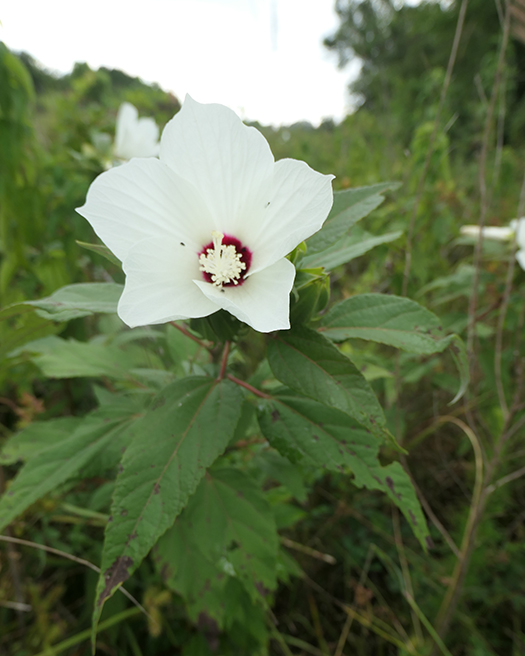
mallow
Hibiscus aculeatus, H. moscheutos (P)
4–6 ft; erect shrublike stems arising from woody crown, petiolate leaves up to 3.5 in. long with three to five deeply cut coarsely toothed and rough-hairy lobes, white to pink 5–8 in. wide funnel-shaped flowers with maroon throat and five rounded petals flowers solitary on stalks from leaf axils
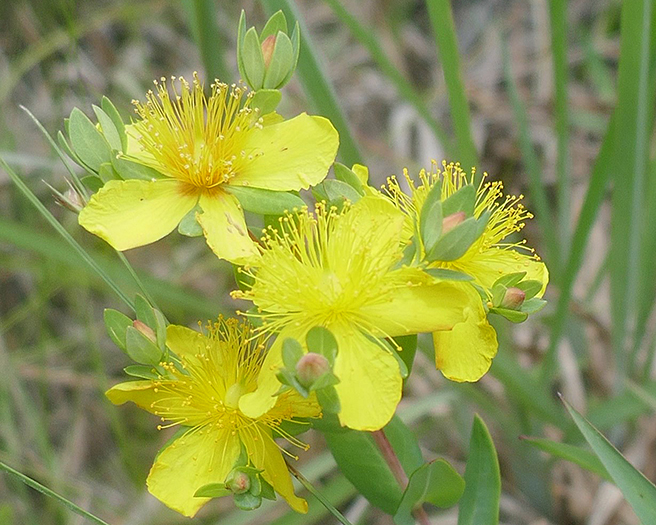
Saint John’s wort
Hypericum spp. (P)
4–18 in.; stems reclining at base, oval to narrowly oblong 0.5–1.5 in. long leaves with a bluish tip and three to five smooth parallel veins, light orange to yellow 0.25 in. wide flowers in loose branching terminal clusters
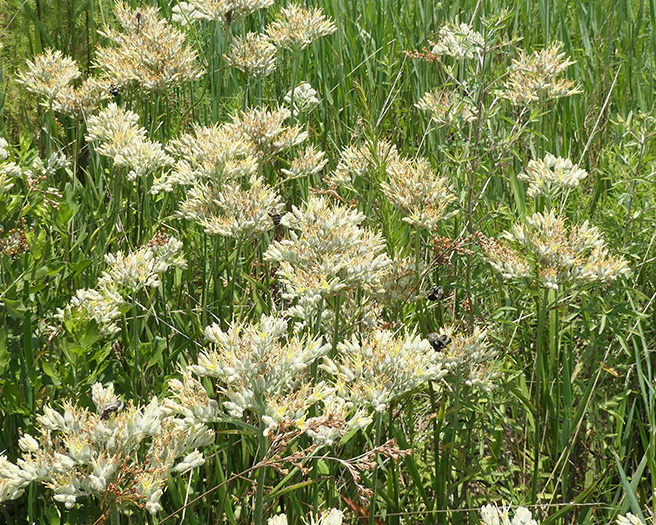
redroot
Lacnanthes caroliniana (P)
1–3 ft; unbranched stems, mostly basal overlapping 18 in. long and 0.75 in. wide leaves, 0.33 in. long pale yellow and green flowers in a terminal generally flat-topped cluster with three erect petals

Virginia lespedeza
Lespedeza virginica (P)
1–3 ft; a few to many stems, well- spaced, short-petioled leaves divided into three 1 in. long elliptical to oblong-oval leaflets, 4–6 pale purple to pinkish-white 0.25 in. long flowers on stalks from upper leaf axils
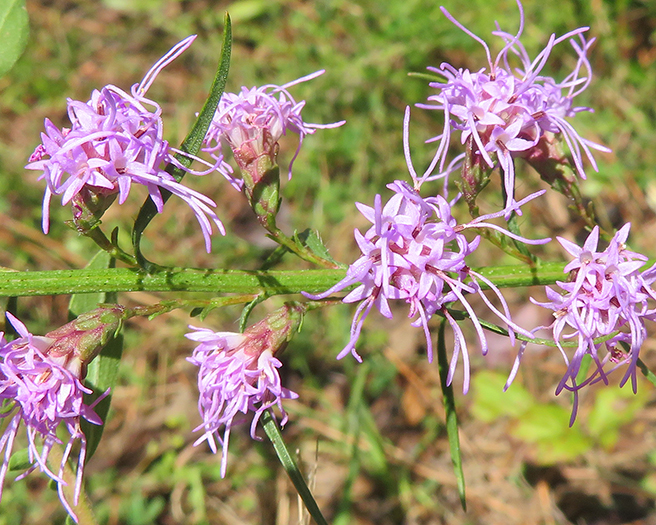
blazing star
Liatris spicata, L. tenuifolia, L. elegans, L. squarrosa (P)
1–4 ft; unbranched stem, mostly clumped 12 in. long linear leaves toward the base of the plant, about 1 in. four to five pale pink to white flower heads densely arranged along a spike, five-lobed disks
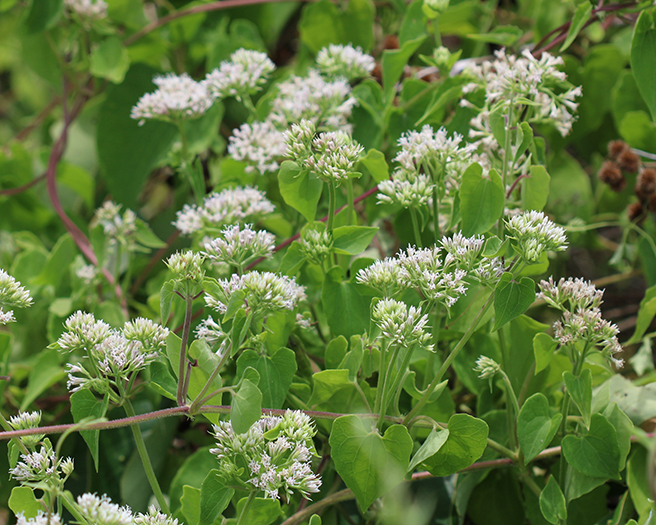
climbing hempvine
Micania scandens (P)
5+ ft; twining vine with cordate 2–3 in. long leaves, flat-topped clusters of white or pinkish flower heads rising from the leaf axils
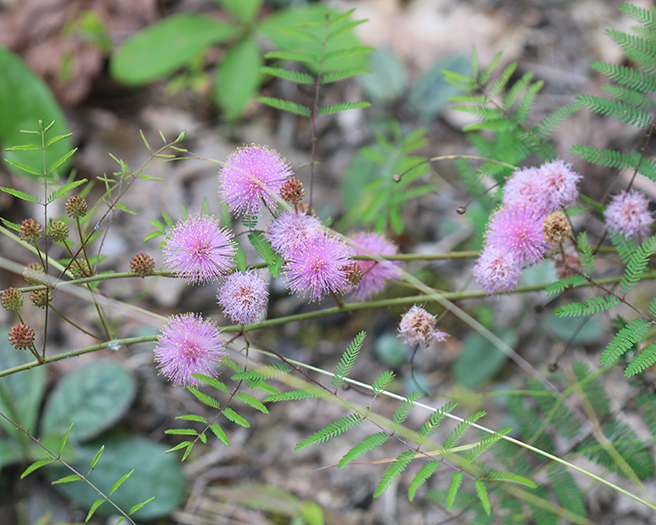
sensitive-briar
Mimosa microphylla (P)
3–6 ft; weakly arching stems covered with hooked hairs, petiolate leaves oblong and sensitive to touch that fold at night and during overcast weather, pompom-like clusters of flowers 0.75 in. wide
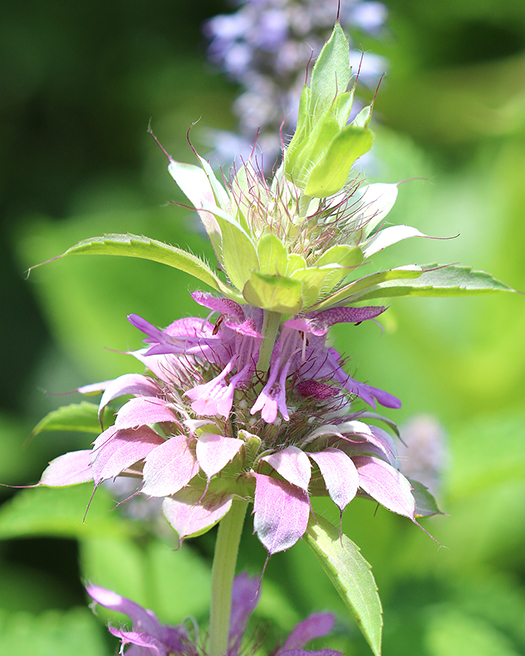
horsemint
Monarda punctata (P)
2–4 ft; square stems, lanceolate or narrowly oblong–3 in. long leaves that appear white and hairy, tubular lipped 13–15 nerved corolla pale yellow and spotted with purple flowers in 2–5 small compact, head-like cymes
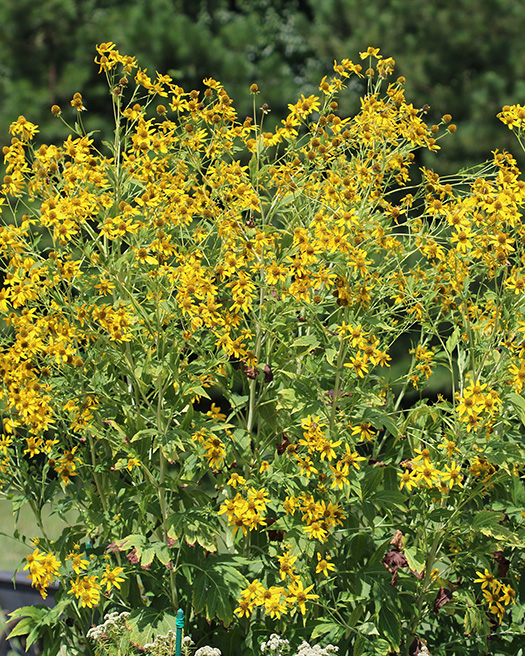
rudbeckia
Rudbeckia spp. (P)
3–7 ft; smooth branches with white waxy coating, petiolate drooping lance shaped to broadly oval leaves, 1.5 in. wide flower heads solitary on long, erect stalks, five to 13 drooping yellow ray florets
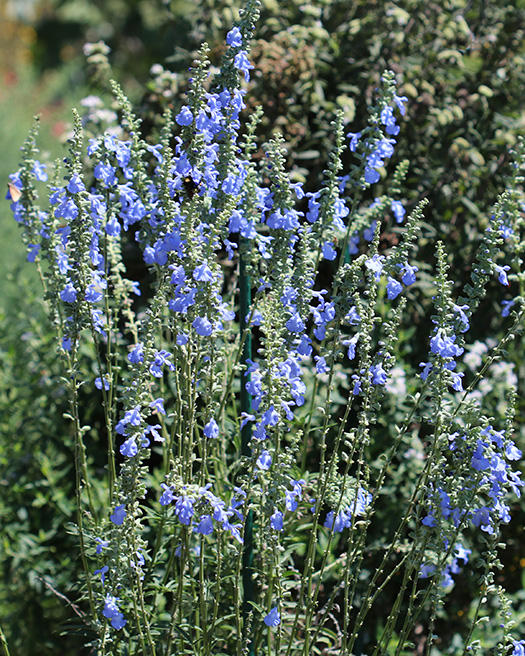
blue salvia
Salvia azurea (P)
1–3 ft; narrowly elliptical to lance- shaped 3.5 in. long greyish green leaves, 0.5–1.5 in. long intense blue flowers in erect loose terminal spikes
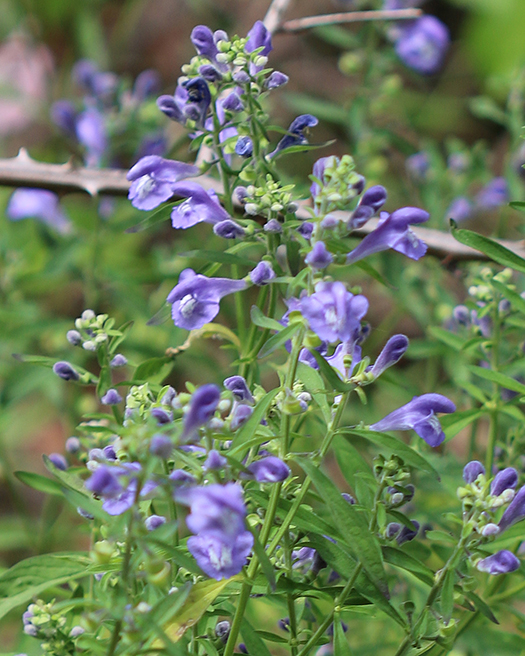
skullcap
Scutellaria spp. (P)
1–2 ft; single to many stems, petiolate oval to lance-shaped to narrowly elliptic leaves, bluish purple flowers in terminal raceme up to 8 in. long
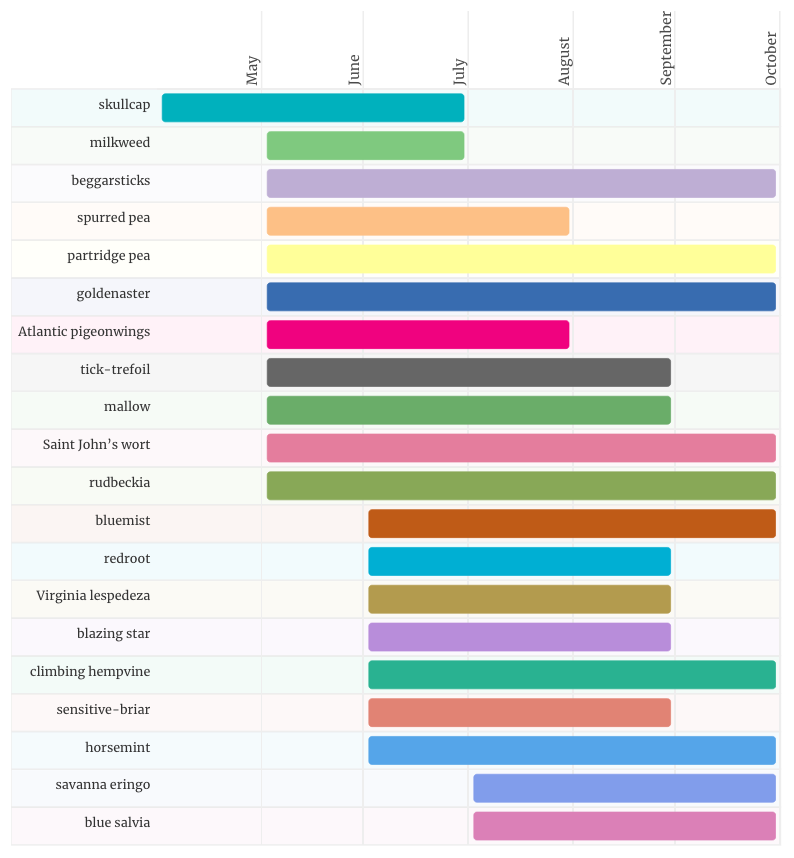
Species That Bloom in Fall
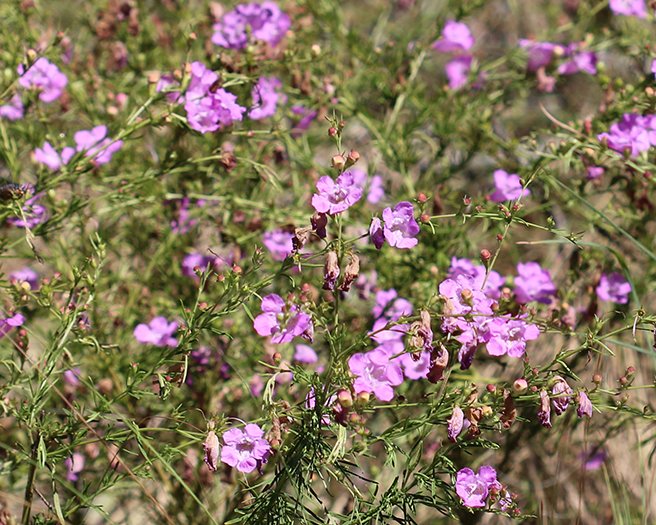
gerardia
Agalinis spp. (A,P)
1–3 ft; erect to sprawling, slender or wiry stems, branched above, linear to needlelike 0.5–2.5 in. long dark green leaves, pinkish-purple tubular and bell- shaped flowers in a terminal raceme up to 1.5 in. long, five spreading rounded lobes
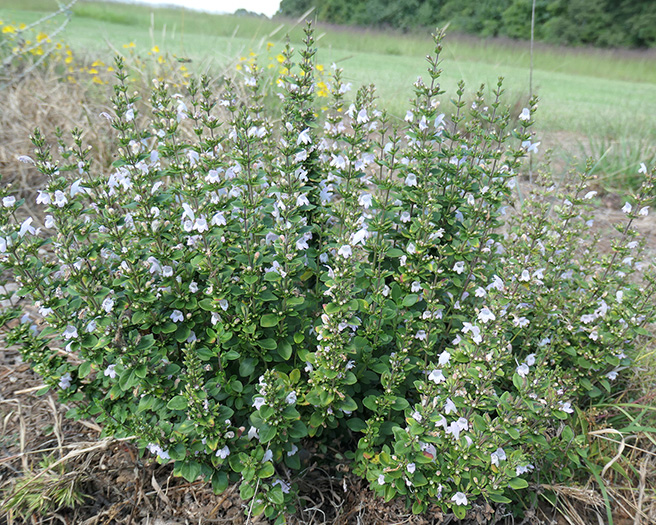
Georgia calamint
Clinopodium georgiana
1–2 ft; erect, shrubby, woody stems branched and with hairy twigs, short- petioled oval to elliptical toothed and aromatic leaves up to 1.5 in. long, three to nine lavender to pale pink flowers in elongated terminal clusters mixed with leaflike bracts; each flower is about 0.5 in. long and tubular with two flaring lips
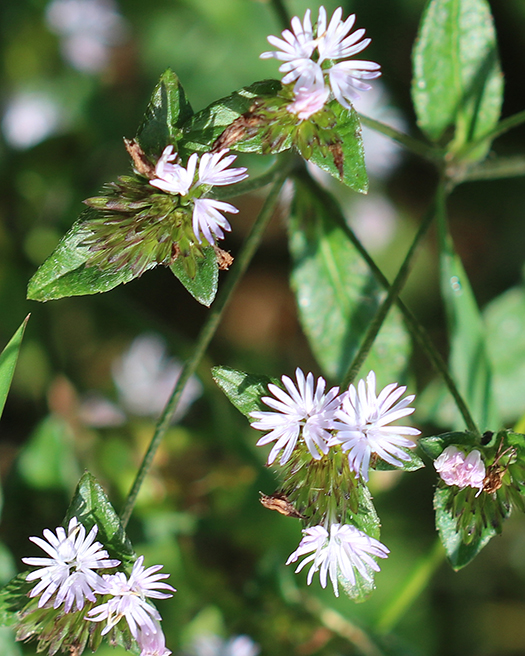
elephant’s-foot
Elephantopus carolinianus, E. nudatus, E. tomentosus (P)
1–3 ft; simple stems or with forked branches, sessile oval to elliptical or even diamond shaped,2–8 in. leaves on winged petioles, lavender pink flower heads in clusters at tips of branches, disks with five lobes
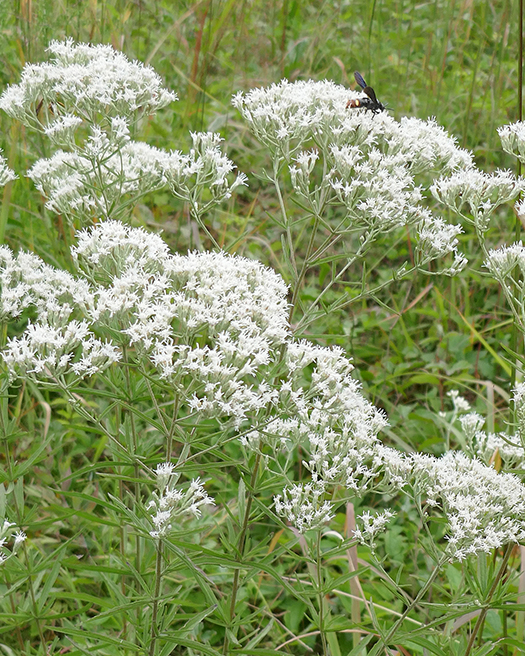
thoroughwort
Eupatorium spp. (P)
1–4 ft; branched stems, mostly sessile oval to lance-shaped 1.5–5 in. long leaves, narrow erect flower heads that appear fuzzy and are in branching terminal cluster, 0.33 in. five-lobed tubular disk
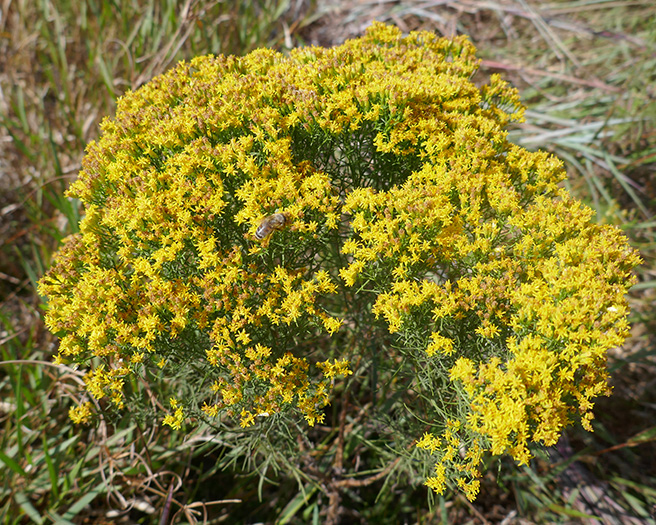
goldentop
Euthamia caroliniana (P)
1–3 ft; unbranched smooth to slightly hairy stems, linear 1– 2.5 in. long leaves; 0.33 in. wide yellow flower heads in large branched terminal clusters
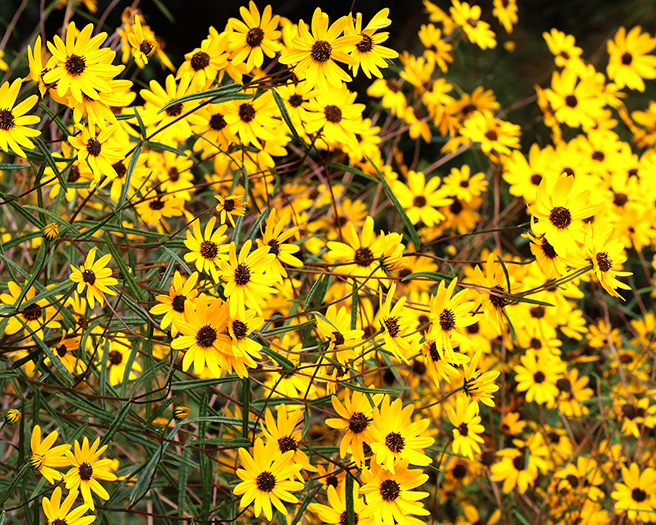
sunflower
Helianthus angustifolia, H. radula, H. debilis, H. floridanus, H. hirsutus, H. strumosus (P)
1–6 ft; branched leafy and rough/ hairy stems, alternate and opposite linear 8 in. long leaves; 1.5–3 in. wide yellow flower heads solitary or in small clusters, eight to 21 yellow florets
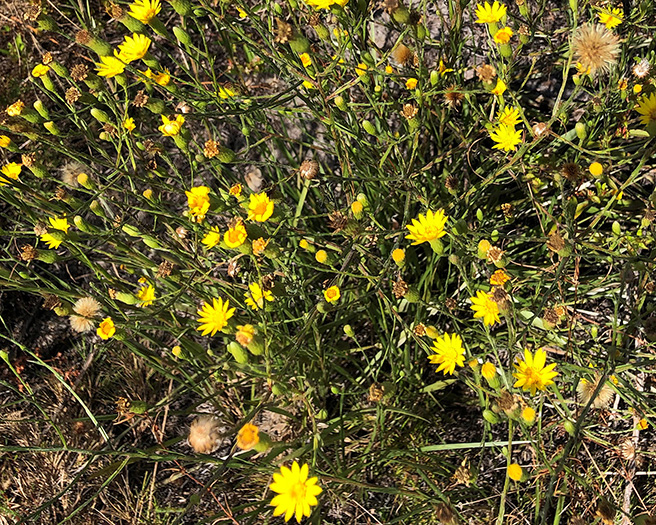
narrowleaf silkgrass
Pityopsis graminifolia, P. aspera (P)
8–18 in.; branched stems in inflorescence covered with a mixture of silky hairs and gland-tipped hairs, linear-lance shaped leaves mostly toward stem bottom, 0.5 in. wide yellow flower heads, eight to 13 ray florets
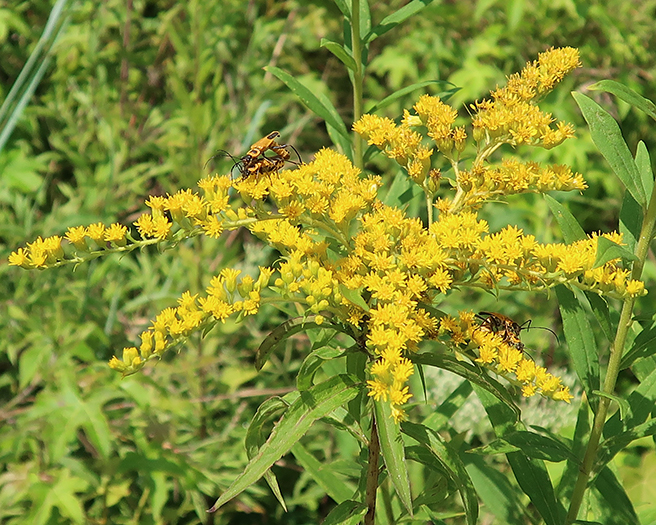
goldenrod
Solidago spp. (P)
1–5 ft; arching branched or unbranched stems, alternate sessile crowded lance-shaped to linear 1–6 in. long leaves, yellow flower heads clustered along spreading-ascending curving branches of a pyramid shaped panicle, eight to 14 ray florets
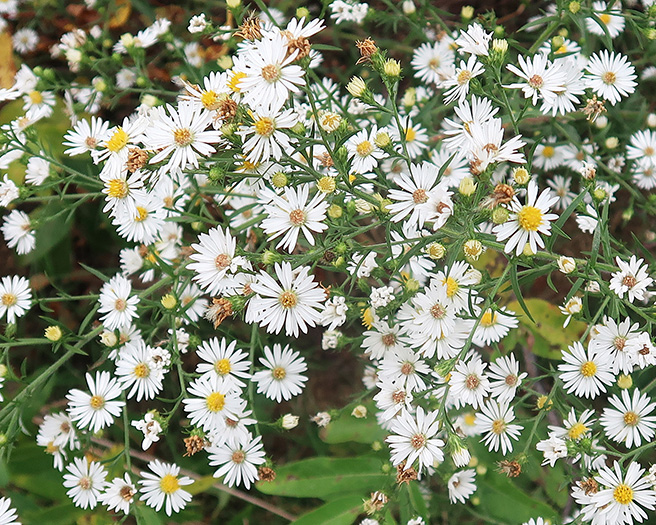
aster
Symphyotrichum spp. (P)
6 in.–4 .5 ft; one to several stems, 0.75–4.5 in. long lance-shaped leaves, 0.5–0.75 in. wide, white, pink, or blue flower heads in a diffuse panicle with stiffly ascending or spreading branches
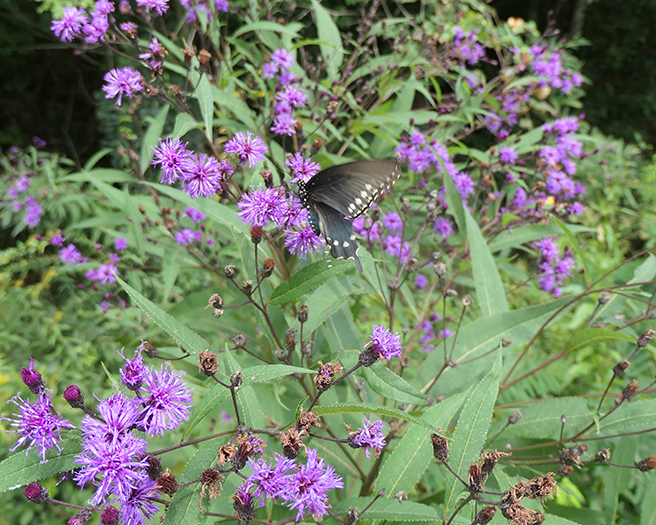
ironweed
Vernonia angustifolia, V. gigantea, V. noveboracensis (P)
3–10 ft; stout ribbed hairy or smooth stems, 12 in. long lance-shaped sharply toothed leaves that are typically rough-hairy on the bottom, pink flowers in terminal heads, 12–30 tubular florets
